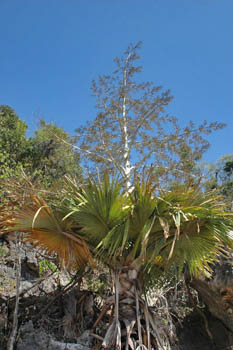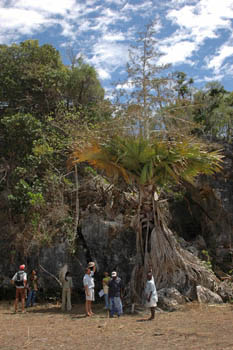New genus of palm discovered on Madagascar
by Christina Harrison, Royal Botanic Gardens, Kew
 A Kew palm expert, John Dransfield, and student Mijoro Rakotoarinivo, have discovered a new genus of palm on Madagascar. Tahina spectabilis, which only exists in the remote north west of the island grows to 18 m high and is the tallest palm in the country. Madagascar has a diverse palm flora and it was a great surprise to botanists to find a new genus here; and especially one whose closest relative is found in Asia.
A Kew palm expert, John Dransfield, and student Mijoro Rakotoarinivo, have discovered a new genus of palm on Madagascar. Tahina spectabilis, which only exists in the remote north west of the island grows to 18 m high and is the tallest palm in the country. Madagascar has a diverse palm flora and it was a great surprise to botanists to find a new genus here; and especially one whose closest relative is found in Asia.
The palm has a huge trunk and enormous fan leaves which are 5m in diameter. It has an unusual and spectacular lifecycle; growing to its full height before the stem tip converts into a giant terminal inflorescence and bursts into branches of hundreds of tiny flowers. Each flower is capable of being pollinated and fruiting, and soon drips with nectar surrounded by swarming insects and birds. The nutrient reserves of the palm deplete as soon as it fruits and it collapses and dies.
This discovery came about when a photograph of the unidentified palm, taken by Xavier Metz, was posted on the website PalmTalk. Metz, a Frenchman who manages a cashew plantation nearby, had seen the palm with its huge pyramidal flowering structure, when walking in a remote area of north-western Madagascar. His photograph caught the eye of John Dransfield (co-author of the Field Guide to the Palms of Madagascar and an Honorary Research Fellow of Kew), and research began in earnest to discover the palm and its identity. “I could hardly believe my eyes when I saw the images posted on the web,” he said. “The palm appeared superficially like the Talipot (Corypha) palm of Sri Lanka, but that had never been recorded for Madagascar. Clearly this was going to be an extremely exciting discovery and I just couldn't wait to examine specimens in detail.”
 "The most exciting of them all"
"The most exciting of them all"
Rakotoarinivo was sent to take specimens, and work on its identification by Kew and Fairchild Tropical Botanic Gardens began. After DNA analysis by Kew’s Jodrell Laboratory Dransfield's conclusion was confirmed; the palm was not just a new species but an entirely new genus within the tribe Chuniophoeniceae. There are only three other known genera in this tribe, Nannorrhops in Arabia, Iran, Afghanistan and Pakistan, Kerriodoxa in southern Thailand and Chuniophoenix in Vietnam, southern China and Hainan. "The tribe has an extraordinary distribution and it is very difficult with current knowledge to explain how it could ever have reached Madagascar" said Dr Dransfield. "Ever since we started work on the palms of Madagascar in the 1980s, we have made discovery after discovery – new species and new genera – but to me this is probably the most exciting of them all".
With less than a hundred individuals, this new palm presents significant challenges to conservationists, especially as the habitat seems so limited and flowering and fruiting events so rare. There are few opportunities to manage regeneration at the site or to disseminate it to botanic gardens in Madagascar and elsewhere. The palm highlights the conservation challenges for all palms in Madagascar, many of which are seriously threatened with extinction through habitat loss.
The paper detailing its discovery was published in January 2008 in the Botanical Journal of the Linnean Society. The name Tahina means 'blessed' or 'to be protected' and is also the name of the daughter of the discoverer of the palm Anne-Tahina Metz. It is planned that seed will be preserved for conservation and also to help generate revenue for local people who can sell the palm to botanic gardens and growers around the globe.